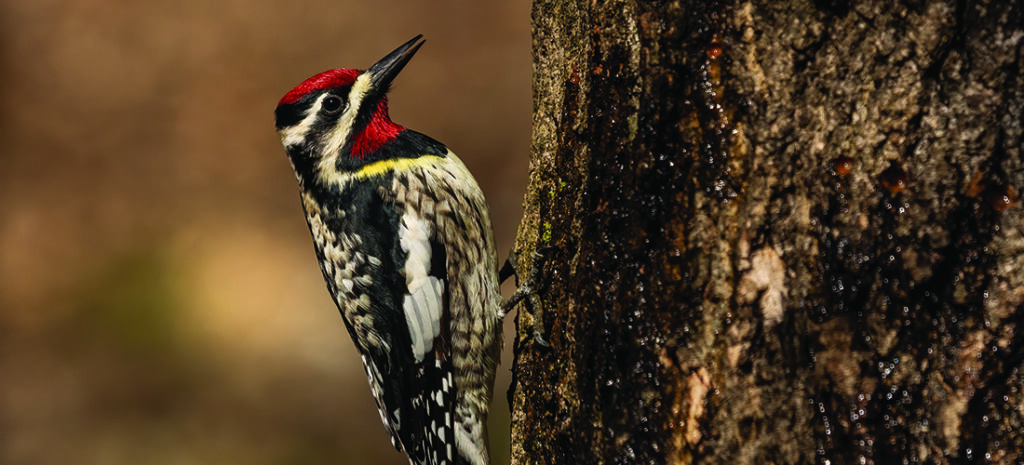Birdwatch

A Winter Visitor
The handsome yellow-bellied sapsucker
By Susan Campbell
Woodpeckers abound in central North Carolina, even more so in the Sandhills. On a given day, you might see up to eight different species. Only one, however, is a winter visitor: the handsome yellow-bellied sapsucker. This medium-sized, black-and-white bird is well camouflaged against the tree trunks where it is typically found. It also sports red plumage on the head, as so many North American species do. The female has only a red crown, whereas the male also sports a red throat. And, as their name implies, both sexes have a yellow tinge to their bellies. However, young of the year arriving in late October to early November are drab, with grayish plumage and lacking the colorful markings of their parents. By the time they head back north in March, they too, will be well-patterned.
There are four sapsucker species found in North America. The yellow-bellied has the largest range and is the only one seen east of the Rockies. Sapsuckers do, in fact, feed on sap year round. They seek out softer hardwood trees and drill holes through the bark into the living tissue. This wound will ooze sap in short order. Not only do the carbohydrates in the liquid provide nourishment to the birds, but insects also get trapped in the sticky substance. Holes made by yellow-bellied sapsuckers form neat rows in the bark of red maples, tulip poplars and even Bradford pears in our area. Pines, however, not only tend to have bark that is too thick for sapsuckers to penetrate but rapidly scab over, rendering only a very brief flow of sap.
The injury caused by sapsuckers is generally not fatal to the tree, as long as it is healthy to begin with. Infection of the wound by fungi or other diseases may occur in older or stressed trees. Although the relationship is not mutually beneficial, sapsuckers need the trees for their survival. It is also interesting to note that others use the wells created by sapsuckers. Birds known to have a “sweet tooth,” such as orioles and hummingbirds, will take advantage of the yellow-bellied sapsucker’s handiwork.
The species breeds in pine forests throughout boreal Canada, the upper Midwest as well as New England. We do have summering populations at elevation in western North Carolina. It is not unusual to find them around Blowing Rock in the warmer months. As is typical for woodpeckers, sapsuckers create cavities in dead trees for nesting purposes. They use calls as well as drumming to advertise their territory. The typical call note is a short, high-pitched, cat-like mewing sound. They use more emphatic squealing and rapid tapping of their bills against dead wood or other suitable resonating surfaces to warn would-be competitors of their presence.
In winter, yellow-bellieds quietly coexist with the other woodpeckers in the area. They will seek out holly and other berries in addition to feeding on sap. These birds will feed on suet, too, and may be attracted to backyard feeding stations. Generally the yellow-bellied does not drink sugar water, since feeders designed for hummingbirds or orioles are not configured for use by clinging species. Of course, as with all birds, it may be lured in by fresh water: another reason to maintain a birdbath or two — even if you live on a lake.
Seeing a sapsucker at close range is always a treat, so keep an eye out for this unusual woodpecker. PS
Susan Campbell would love to hear from you. Feel free to send questions or wildlife observations to susan@ncaves.com.
